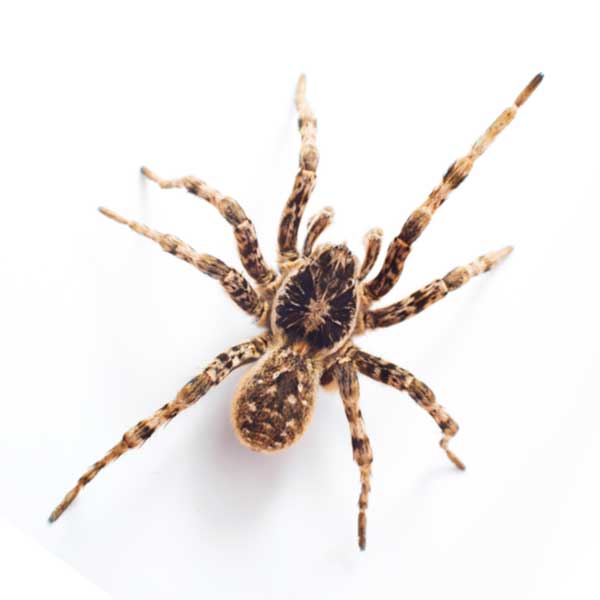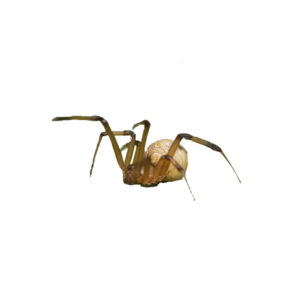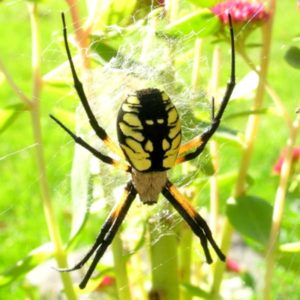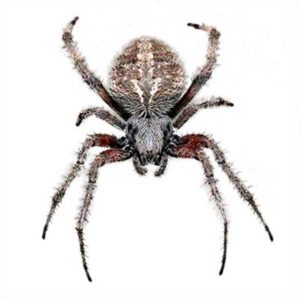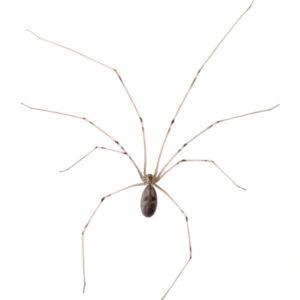Wolf Spider Identification
What Do Wolf Spiders Look Like?
Wolf spiders are robust and agile hunters, known for their large size and hairy bodies. They range in color from brown to gray and have distinctive markings, often including stripes or a Union Jack pattern on their back. Their eight eyes are arranged in three rows, with the two large eyes in the middle giving them excellent vision. Shining a flashlight at ground level will often allow one to see the green eye shines of this spider reflected from 10-30 feet away, depending on the spider’s size. Wolf spiders are rarely pests, but they sometimes wander into houses, where their large size often frightens homeowners. Unsure whether it’s a wolf spider? See our common spider species to help identify the species and understand more about how to tackle an infestation.
Signs of a Wolf Spider Infestation
Signs of a wolf spider infestation include sighting these large, fast-moving spiders in and around your home. Unlike other spiders, they do not create webs, so their presence is noted more by direct sightings.
Habitat, Diet, Life Cycle & Bites
Where Do Wolf Spiders Live?
Wolf spiders are ground-dwellers that prefer living in gardens, lawns, and under rocks or logs. Indoors, they can be found in basements, garages, and lower-level areas, especially where there is clutter.
Diet of a Wolf Spider
Their diet primarily includes insects and other small invertebrates. They do not use webs to capture prey and actively hunt in the open during the day and night, often living by the thousands in leaf litter and grassy areas.
Life Cycle of a Wolf Spider
The life cycle of wolf spiders includes distinct egg, spiderling, and adult stages. Females carry their egg sacs attached to their spinnerets and later carry their young on their back for a few weeks after they hatch.
Wolf Spider Bites
Wolf spiders can bite, but their bites are extremely rare. While they may be fast and aggressive when hunting their insect prey, they don’t usually bite people unless they are provoked or mishandled. A wolf spider bite may be painful, but it is not generally dangerous to healthy adults. However, sensitive individuals such as children, the elderly, and people with compromised immune systems may have some form of negative reaction.
Are Wolf Spiders Dangerous?
Wolf spiders are not considered dangerous to humans. While they can bite in self-defense, their venom is not toxic to humans, and they are generally non-aggressive.
How to Get Rid of Wolf Spiders?
To reduce wolf spider presence, eliminate their hiding places by keeping areas clean and clutter-free. Seal cracks and openings to prevent their entry into the home. Our professional spider exterminators can help you remove persistent spiders with our highly effective treatments and long term prevention methods.
Wolf Spider Prevention Tips
Prevent wolf spiders by maintaining a tidy environment, both indoors and outdoors. Regular vacuuming and reducing outdoor lighting that attracts insects can help deter them.
Need help with Wolf Spiders control?
FAQs
What Should I Do If I Find a Wolf Spider in My House?
If you find a wolf spider in your home, it is usually best to leave it alone or gently guide it outside. They are beneficial as they prey on household pests.
Are Wolf Spider Bites Dangerous?
Wolf spider bites are generally not dangerous. While they can cause pain and swelling, they are not toxic to humans.
What Attracts Wolf Spiders in the House?
Wolf spiders are often attracted to homes in search of prey or shelter. They can enter through gaps and cracks in search of insects.
Can a Wolf Spider Jump?
Wolf spiders are capable of making small jumps, especially when hunting or evading threats.

